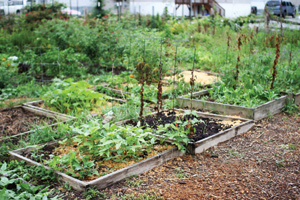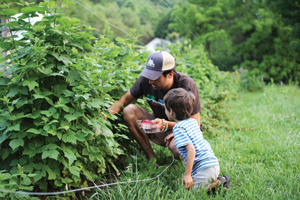Garden Advice from the Experts!
As we prepared this agriculture-themed issue of The Appalachian Voice, we couldn’t help but think of how to improve our own green thumbs. We took the following questions to Ruth Gonzalez and Meredith McKissick at the Organic Growers School, a nonprofit that promotes sustainability through educational opportunties in Southern Appalachia.
1. Is there a way to keep the band of deer away from my small beds without building an enormous fence? How?
Although enormous fences are the most reliable protection, Havahart DeerOff and Plantskydd Deer Rabbit Vole Repellent are two natural and organic options you can try. Active ingredients vary by product, but can include garlic, capsaicin hot pepper and putrescent whole egg solids; they work by assaulting the deer’s senses of taste and scent.
2. How can I stop slugs, blight or aphids without pesticides? What are the best homemade options?
Safer Soap will control aphids, and beer traps and/or Sluggo (iron phosphate) work for slugs. For blight, use compost tea along with rotating spray treatments of Serenade and copper sulfate fungicides.
Here is the OGS executive director’s favorite recipe for homemade garlic soap spray, which is effective against many insect pests including cabbage loopers (adults and caterpillars), aphids, squash bugs, tarnished plant bugs, slugs, hornworms, leafhoppers, whiteflies, squash bugs and earwigs.
25 cloves unpeeled garlic or 2 cups minced, tender garlic scapes, or 3 tablespoons garlic powder
2 teaspoons mineral oil
2 teaspoons liquid castile soap
2 cups warm water
Press garlic or crush it in a small food processor. Place the crushed garlic and juice in a glass or jar with the mineral oil, stir just a little, and let istand 24 hours (though longer is okay). After the wait, in a separate bowl combine the garlic oil mixture, castile soap and water. Mix well, then strain into a mason jar. Store in the fridge for up to three weeks. To use, dilute 1-2 tablespoons concentrate into 2 cups of water. Spray your plants thoroughly. The garlic odor will not ruin your plants or make them taste garlicky, so spray well!
3. How do you know when compost is ready for the garden?
The compost should smell sweet, look rich and dark, and ideally should have heated up enough to kill weed seeds and pathogens. Optimally, the pile should be at least three feet long in all directions to get it to heat up. Read more on composting at: bit.ly/18AbO1C
4. What are the best plants to grow with your kids in a “starter garden?”
Planting seeds that come up quickly is always a good bet with children. Beans and peas are very big, easy-to-handle seeds that sprout rather dramatically. Sunflower seeds, squash, and cucumbers fall into that category, too. Radishes come up in three to seven days, mature in three to four weeks and can be eaten right out of your unsprayed garden. Carrots take longer than radishes, but most kids are familiar with carrots and it gives them a big thrill to pull them up and eat them (us too!).
Kids will graze on things in the garden that they would not touch at the dinner table — try parsley or lettuce. Unsprayed edible flowers also add a touch of magic to your garden harvest. Some mildly flavored common ones would be pansies, violas, impatiens and calendula. Learn more at: bit.ly/11EA67Z
5. How can I tell if a particular vegetable I want to grow in my garden has been genetically modified?
Certified organic growers are not allowed to use genetically modified seeds or transplants. If you buy organic seed and organic transplants, your vegetables should be GMO-free. Learn more at: bit.ly/18CfgX9
For monthly gardening advice from Organic Growers School, sign up for their e-newsletter at organicgrowersschool.org and email your agriculture questions to enews@organicgrowersschool.org
Related Articles
Latest News
More Stories

Leave a comment
Your email address will not be published. Required fields are marked *






